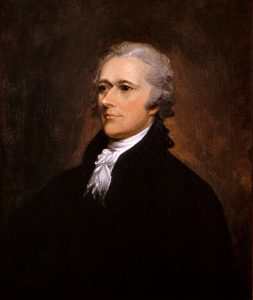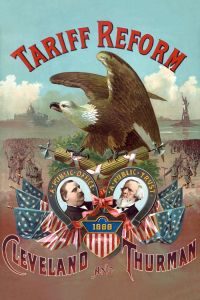
Not by the Book
Turn on any news channel in today’s political environment and prepare to be met with concerning headlines about where financial markets and the United States economy might be headed because of 45th Republican President Donald Trump’s implementation of tariffs[1] [2]. The thought process behind imposing tariffs is to protect domestic industries from foreign competitors which, in turn, should spur economic growth at home. Economists throw the textbook at the President’s actions, arguing that imposing tariffs is not an ‘ideal’ approach to fiscal policy and global trade because such a stance may lead to pricing wars and price inefficiency, slowing global growth. News outlets and economic pundits argue implementing any sort of tariff is damaging to the economy and a no-tariff or ‘fairer’ approach to trade policy should be assumed by the Oval Office.

However, history has proven that Republicans and Democrats have frequently crossed the aisle on trade policy for the sole reason to preserve domestic economic prosperity irrespective of their party’s core beliefs or what media gurus say. In fact, a similar reaction to tariff implementation was proposed by 2016 Democratic Presidential Candidate Hillary Clinton[3] and even enacted by the 44th Democratic President Barack Obama.[4] We present events in this blog that point to historical instances in which Republicans and Democrats have gone against ‘ideal’ trade policies in favor of what was pragmatic and beneficial to the American entrepreneur even if that meant crossing the aisle and infuriating their fellow Cabinet members.
This continuous disconnect between Presidents using their ‘gut feeling’ to govern trade policy and what is thought to be ‘ideal trade policy’ described in economic textbooks[5] can cause confusion amongst the public and instill unnecessary fear. To understand a topic as vast and complex like U.S. trade policy, investors should understand its history first, which will help add context, then begin to delve into specific details after rather than attempting to learn it in a backward like fashion. We argue history proves that regardless of which political party holds office, current and past presidents’ actions on trade policy have never followed the book but were rather dictated by practicality and a one-size fits all mold.
$10 Marks the Spot

Appointed by 1st American president George Washington, Alexander Hamilton known as the pioneer of United States commerce, banking, and manufacturing sought to upgrade the 18th-century American agrarian economy consisting of exporting tobacco, cotton, and grains to a world leader in higher-value-added industries such as transport, steel, and mining. However, Britain wanted America to remain an agrarian economy because the purpose of the colonial enterprise was to provide Britain what it needed cheaply to be resold for a profit, increasing revenues to the Crown while keeping the U.S. economy on the tarmac. At the time, America needed a way to raise funds to expand into more advanced industries and compete with Britain. [6]
The Hamilton Approach
Presidents exhibiting American protectionism through tariff implementation is not a new practice. In fact, to state that economic policy can be labeled as ‘Left’ or ‘Right’ idea would be difficult to prove. Since the Founding Fathers, the Hamiltonian Economic Model has been the long-adopted approach to governing economic policy since its creation. A Hamiltonian Economic model consisted of four pillars reinforced economically and politically.
The model included: [7]
- High import tariffs
- High spending on infrastructure
- An assumption of the states’ debt by the federal government
- A central bank
The 100+ Year Old ‘Active’ Tariff
In his 1791 Report on Manufacturers, Alexander Hamilton set out to gain public support for his four-pillar economic model consisting of high tariffs on imports to boost American economic development and support nascent industries to compete with Britain.[8]
Hamilton quoted in his 1791 Report:
“The wealth…independence, and security of a Country, appear to be materially connected with the prosperity of manufactures. Every nation…ought to endeavor to possess within itself all the essentials of national supply. These compromise the means of subsistence, habitation, clothing, and defence…”
The first tariff ever to be enacted by Congress strongly advocated for by tariff frontman Alexander Hamilton, was in 1789. Although the names of the tariffs and rates that were imposed fluctuated throughout this period (5%-50%), a protective tariff was in ‘active’ status from 1789 to 1930 in our nation’s history.[9] It was because of Alexander Hamilton and his active-government economic plan that was in fact preserved, not reinvented nor discarded, by presidents throughout American history that catapulted the United States out of the agricultural minors (Colonial Agrarian period), into the manufacturing majors (Industrial Revolution), then continuing into the Digital Age.
Crossing the Aisle
But before the United States could find its success in manufacturing through the successful implementation of tariffs, it must have found its opposition in Washington D.C. first. Hamilton’s high tariff, active-government, economic model received opposition from known ‘yeoman’ and 3rd President of the United States, Thomas Jefferson, his party of small-government Democratic-Republicans, and 4th President James Madison.[10] Despite initial opposition and after the disbanding of Hamilton’s Federalist Party, Jefferson, Madison, and the Democratic-Republicans preserved the Hamiltonian Economic Model because they knew it worked, becoming our nation’s first aisle-crossers.
Fitting the Mold
Thomas Jefferson abandoned his philosophy of limited government as he wielded the high powers of office to purchase the Louisiana Territory from France in 1803.[11] Although Jefferson did not favor tariffs during his term, he supported James Madison in the passing of the protective Dallas Tariff of 1816. As America flirted with bankruptcy in the light of the War of 1812 due to war bonds going into default resulting in a run on state banks, the need for a central bank was becoming more imperative. Finally, after vetoing the bill the first time and foregoing a 20-year long opposition to the formation of a central bank, James Madison allowed Congress to establish the United States first National Bank. A second National Bank was signed into law in 1816.[12]

After Congress enacted the Tariff of 1828 which increased export duties as high as 50% on raw materials from the Confederate states, South Carolina attempted to bear arms against the federal government and ignore federal law. In response to South Carolina’s protest and refusal to follow the law, 7th U.S president Democratic-Republican Andrew Jackson, so as not to stray away from Hamilton’s Model, signed the Force Bill in 1833 which authorized the federal government to use military action to enforce the tariff.[13]
Promising to uphold and owing his election to 15th U.S. Democratic President James Buchanan’s Morrill Tariff of 1861, which increased the average tariff rate from 15% to 37.5% then eventually to 45%, 16th Republican President Abraham Lincoln touted in his first inaugural address the potential use of military force if the tripled tariff was not collected from the Confederate South.[14] [15] Early political party history and its metamorphosis into modern-day Republicans and Democrats is complex, however American trade policy has never been clearer.
If It Isn’t Broke, Don’t Fix it

In a move to reduce the surplus in the federal treasury, Former 22nd and 24th Democratic President Grover Cleveland proposed reducing tariffs as part of his re-election campaign of 1888. However, Cleveland was met with warnings from politicians saying he would lose the support of American businesses. Reluctant to follow the economic model that had been put in place almost 100 years before, Grover Cleveland decided to rally for the reduction of tariffs. He was met with defeat by 23rd Republican president Benjamin Harrison, despite winning the popular vote.[16] During his presidency, Harrison supported the McKinley Tariff of 1890, which raised tariffs to 50%.[17] Grover Cleveland regained the presidency in 1892 after shifting his campaign’s emphasis to other issues. [18]
Crossing the Aisle, Part II
Upon entering office after the successful implementation of the New Deal, America’s first benefits package post-Great Depression (1933) by 32nd Democratic President Franklin D. Roosevelt (FDR)[19] and successful continuation by 33rd Democratic President Harry Truman, 34th Republican President Dwight D. Eisenhower was making Democrats hold their breath as he had been the first Republican to assume presidency after the landmark deal. However, as the country struggled to resume its economic recovery, Eisenhower blurred party lines as he legitimized active government and the Democrat’s New Deal. After ending the Korean War, Eisenhower conserved critical parts of the New Deal including the financial and labor regulation reform, income distribution plan, and a high level of military spending. Increased military spending and pragmatic legislation by Eisenhower set the United States on the path towards the Internet Age.
Eisenhower made Republicans bark as he kept in place the 91% income tax rate, America’s highest tax rate ever, which helped to fund the government and the massive spending spree it was on. In 1962, with a population of approximately 180 million people, the United States federal government employed 5,354,000 people. In 2010, 4,443,000 American citizens were federal government employees with the country’s population sitting at just over 300 million. Eisenhower proclaimed, “should any political party attempt to abolish social security, unemployment insurance and eliminate labor laws, and farm programs, you would not hear of that party again in our political history…”[20]
While preserving the New Deal greatly pleased Democrats, Eisenhower’s idea of a more ‘liberal’ and fairer approach to trade policy was met with severe dissatisfaction by protectionists and the U.S. cotton industry as it was a major leap across the aisle in terms of tariff reform but a severe blow to the domestic cotton industry. Eisenhower continued across the aisle when signing the Reciprocal Trade Agreement Act (RTAA) renewal bill H.R. 1, strongly supported by a Democratic Congress and first signed into law by FDR[21] which was intended to promote reciprocal, freer trade amongst the U.S. and its trade partners via the reduction, not elimination, of tariffs. While it may seem as though Eisenhower was a Democrat in disguise, two amendments to implement quotas and tariffs if domestic industries were harmed found their way into the bill, thus preserving the ability to put domestic interests ahead of foreign relations if the time for executive action had arisen, ultimately preserving the Hamilton Economic Model but paving the way for global growth.[22]
After exploring a brief U.S. history on tariffs, it is evident that presidents will use the Hamiltonian Economic Model to govern their fiscal policy. Therefore, arguments surrounding tariffs and global trade should no longer point Left, nor Right, but rather to Alexander Hamilton.
Why It Matters
Emotions stirred by news media outlets and those outside the investment profession can cause stock market volatility and ensue hysteria. Stock market volatility may cause individuals to make investment decisions that may not be opportune at the current time such as selling stocks in an economic recession or being apprehensive about making future investments in economic recoveries. This knee-jerk reaction to emotions driven by the news reported strictly for fear-mongering can cause individuals to assume irrecoverable losses in investment portfolios, postponing investment success.
Subnani Investment Research, LLC will assist in helping our clients ride out economic recessions and potentially capture investment opportunities when fear ensues in the financial markets.
The Rest of the World
As noted above, the Hamiltonian Economic Model will always be the trade policy mold any United States president will assume, regardless of party affiliation. But is the bug of American protectionism just an American approach to trade policy? The short answer is no.[23]
To see how far the Hamilton model has spread to our neighbors across the pond, tune into our next blog!
References:
[1] ‘A schedule of duties imposed by a government on imported or in some countries exported goods.’ – Merriam-Webster
[2] https://www.cnbc.com/2018/07/10/white-house-releases-list-of-goods-hit-by-200-billion-in-tariffs.html
[3] https://money.cnn.com/2016/08/11/news/economy/hillary-clinton-trade/index.html
[4] https://ustr.gov/about-us/policy-offices/press-office/fact-sheets/2015/january/fact-sheet-obama-administration%E2%80%99s
[5] https://www.tutor2u.net/economics/reference/arguments-against-protectionism
[6] Cohen, S. S., & DeLong, J. B. (2016). Concrete economics: The Hamilton approach to economic growth and policy. Boston: Harvard Business Review Press.
[7] Cohen, S. S., & DeLong, J. B. (2016). Concrete economics: The Hamilton approach to economic growth and policy. Boston: Harvard Business Review Press.
[8] https://founders.archives.gov/documents/Hamilton/01-10-02-0001-0007
[9] https://www.timetoast.com/timelines/tariffs-in-us-history
[10] http://www.ohiohistorycentral.org/w/Democratic-Republican_Party
[11] https://www.thoughtco.com/jefferson-and-the-louisiana-purchase-104983
[12] http://www.stateoftheunionhistory.com/2016/12/1815-james-madison-need-for-national.html
[13] https://study.com/academy/lesson/the-force-bill-definition-lesson.html
[14] https://mises.org/library/lincolns-tariff-war
[15] http://avalon.law.yale.edu/19th_century/lincoln1.asp
[16] https://learningenglish.voanews.com/a/tariffs-costs-cleveland-reelection-94928934/115843.html
[17] http://history.house.gov/Historical-Highlights/1851-1900/The-McKinley-Tariff-of-1890/
[18] Cohen, S. S., & DeLong, J. B. (2016). Concrete economics: The Hamilton approach to economic growth and policy. Boston: Harvard Business Review Press.
[19]http://www.loc.gov/teachers/classroommaterials/presentationsandactivities/presentations/timeline/depwwii/newdeal/
[20] Cohen, S. S., & DeLong, J. B. (2016). Concrete economics: The Hamilton approach to economic growth and policy. Boston: Harvard Business Review Press.
[21] https://ustr.gov/about-us/policy-offices/press-office/blog/2014/June/Eighty-years-of-the-Reciprocal-Trade-Agreements-Act
[22] Forsberg, Aaron. “Eisenhower and Japanese Economic Recovery: The Politics of Integration with the Western Trading Bloc, 1952—1955.” The Journal of American-East Asian Relations, vol. 5, no. 1, 1996, pp. 57–75. JSTOR, JSTOR, www.jstor.org/stable/23612817.
[23] Cohen, S. S., & DeLong, J. B. (2016). Concrete economics: The Hamilton approach to economic growth and policy. Boston: Harvard Business Review Press.






